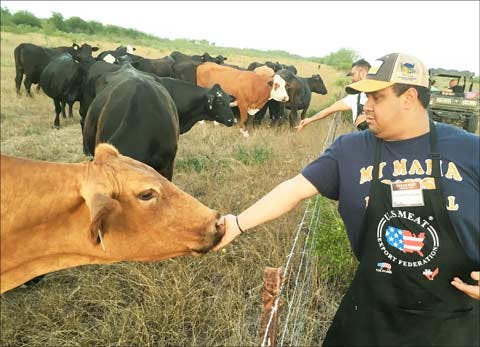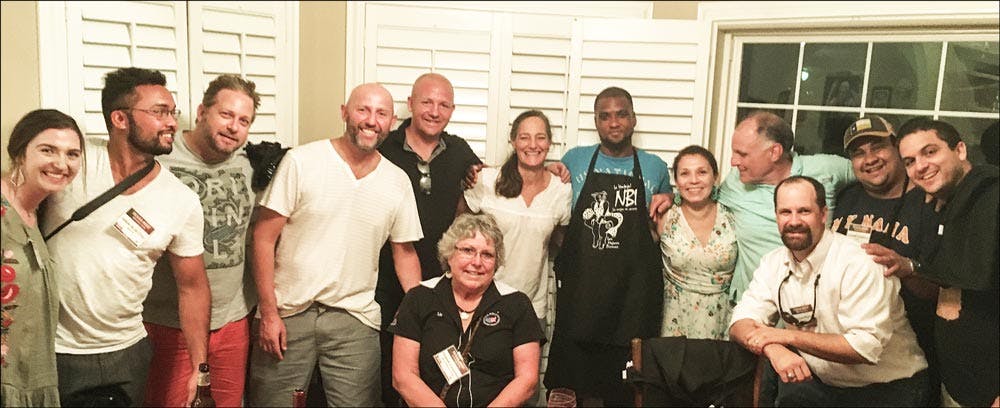Caribbean Chefs Inspired by U.S. Beef Education, Texas Barbecue Themes
Like many of his fellow chefs in the Caribbean, Rene Klop works with cuts of U.S. beef and regularly includes traditional beef dishes on his restaurant’s menu. But as a member of the “Caribbean Barbecue Team” in Texas this week for insights into the U.S. beef industry, Klop has gained a new perspective.

Caribbean Barbecue Team member Rene Klop of Curaçao examines U.S. beef short ribs at the Kane Beef plant in Corpus Christi, Texas
“Not only are we learning about new cuts of U.S. beef – alternative cuts we haven’t used in the past that fit quite well with what we are trying to do in our restaurants – we are also getting to see where the beef comes from and how it is produced,” said Klop, executive chef at Baoase Culinary Beach Restaurant in Curacao. “We now have a story to tell at our restaurants back in the Caribbean. We can serve new dishes made with U.S. beef, including barbecue dishes we discovered in Texas, and we can talk about where that beef was raised, how it was fed and what makes it flavorful.”

Chef Gerald Cardenas of Madero Grill and BLT Steak at the Ritz-Carlton in Aruba, feeds cattle at the Boots Ranch in Alice, Texas
Hosted by USMEF and the Texas Beef Council (TBC), the team is made up of leading chefs from restaurants in Aruba, Bermuda, Curacao and Grand Cayman. Team members were shown how quality U.S. beef is produced and were taught new ways to prepare and serve barbecue cuisine and the variety and profit potential that Texas-style barbecue items can add to restaurant meus. Special focus was put on affordable, lesser-known U.S. beef cuts available to the Caribbean, a market that relies heavily on tourism and is still recovering from the devastating hurricanes of 2017.
“We have found that using the Texas barbecue theme to introduce underutilized beef cuts really works well with our Caribbean customers who want to expand the range of cuts beyond the traditional tenderloin, ribeye and strip,” said Liz Wunderlich, USMEF representative in the Caribbean. “The idea and image of ‘Texas’ definitely sells, and from steakhouses to restaurants with theme nights, it’s a fun way for the Caribbean hospitality industry to give hotel and restaurant guests a fresh new experience.”

A demonstration on breaking down U.S. beef chuck eye on the team’s ranch visit.
Texas beef producers have long recognized the importance of international market development and the opportunities it has to offer, said Richard Wortham, TBC executive vice president.
“Building U.S. beef demand internationally and adding value to the producers’ bottom lines is smart business and we are happy to partner with USMEF on these kinds of activities,” said Wortham.
The highlight of the week was the “Barbecue 101” training at the TBC office in Austin. Described as, “a training with everything you need to authentically conduct a Texas Barbecue Festival,” the session featured USMEF Chef Consultant Jay McCarthy and Jason Bagley, TBC’s senior manager of beef resources. The session included:
- A sensory comparison between U.S. beef skirts, bottom sirloin flap, flank steak and hanger steak
- Instruction on how to manage a barbecue pit – wood selection, temperature and time, building a fire, managing smoke and temperature plus sauce and rub selection
- Demonstrations on using U.S. beef alternative cuts such as chuck roll, shoulder clod, short ribs, top sirloin butt and tri-tip
- Tastings of each of the featured cuts
- A Texas barbecue theme lunch featuring decorations available for Caribbean island barbecue events
The team’s beef industry tour began earlier in the week at Texas A& M University-Kingsville, where chefs heard an overview of the U.S. beef industry and lessons on the advantages of grain feeding and the positive impacts of proper marbling. A review of beef grading and branded beef programs was followed by an introduction to U.S. beef cuts that are not common in the Caribbean: inside skirt, top blade, bottom sirloin tri-tip, bottom sirloin flap, top sirloin cap, top sirloin center cut and chuck underblade.
Giving the team the opportunity to experience beef production firsthand, USMEF and TBC led the chefs on a tour of the Boots Ranch in Alice and the Graham Land & Cattle Company in Gonzales. The Boots Ranch owners Laura and David Hausman showed off their cow-calf operation and answered team members’ questions about production practices. At Graham Land & Cattle, Josh Gray explained why grain feeding makes such an important contribution to the quality and taste of U.S. beef.

The Caribbean Barbecue Team photographs cattle on the Boots Ranch in Alice, Texas
Continuing with the theme of beef production, the team visited the Kane Beef plant in Corpus Christi to see the steps taken to produce a safe, quality boxed beef product.
To get a consumer point of view, the team did a “barbecue crawl,” hitting a handful of barbecue restaurants in and around Austin. Venues included City Market in Luling, Kreuz Market in Lockhart, Salt Lick BBQ in Driftwood, Stiles Switch BBQ in Austin and Southside Market in Elgin.
They also toured Lone Star Meats, a portion control plant in Austin, where butchers demonstrated innovative cutting of beef sirloin, flat iron and short ribs.
Klop said he was thrilled with the experience and is eager to get back to his restaurant to start planning new menu items.
“Especially in a place like the Caribbean, where we mainly entertain customers who are on vacation and eager to try new things, we cook to be creative and make people happy,” he said. “Thanks to the well-thought-out week of activities in Texas organized by USMEF and the Texas Beef Council, I think each of us on this chef’s team was inspired by what we learned about U.S. beef and the possibilities for new barbecue dishes on our menus.”

The USMEF Caribbean Barbecue Team pauses for a photo with the owners of the Boots Ranch on the team’s visit to Texas
